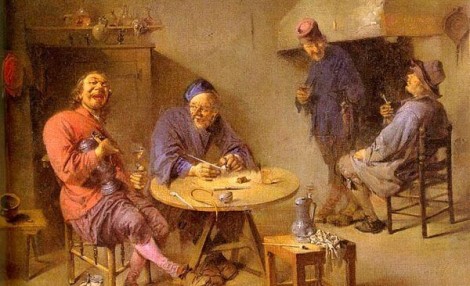Around the 16th century, sniffing, chewing tobacco and especially pipe smoking slowly became the ways to use tobacco in the Netherlands.
In the 17th century smoking was becoming more and more common. There was smoke everywhere: in homes, shops, inns etc. The Netherlands as a trading nation, with Amsterdam as the centre, played an important role in the tobacco trade. English sources depicted the Dutch as chain smokers. And then to think it were English craftsmen, fighting in the army as mercenaries, who learned us to make what later became the famous Gouda pipes.
“A Dutchman without a pipe in Amsterdam is a national impossibility. A city without a house, a stage without an actor, a spring without flowers. A Dutchman could not feel blessed in Heaven without his pipe and tobacco.”
Smoking in the 17th century was a general phenomenon. In the pubs ready filled pipes were sold. Status and wealth were evident in the smoke tradition. For example, rich people owned a silver tobacco box. Poor people had to do with the ready filled pipes. Smoke attributes were a status symbol.
So anno 1750 the entrepreneurial Amsterdam merchant was in the right place at the right time in history. He could dispose of the necessary financial resources, knowledge and trade relations to get rich and successful in the tobacco trade.
Relatively soon the tobacco merchant became a lucrative and respected profession. He could mix imported foreign tobaccos with relatively inexpensive native tobaccos. By doing this the British traders could be outdone with lower market prices. The domestic supply of tobacco also made a welcome addition to the irregular supply of tobacco from Brazil, West Indies and later the East Indies.
The cultivation of tobacco in the provinces of Utrecht and Gelderland especially took off thanks to the interplay (partnership) with the more world-oriented tobacco merchants from Amsterdam. These early capitalist merchants were willing to take (calculated) financial trading risks. Usually the final earnings were more than sufficient. This way they were able to finance the crop of the next year to ensure continuity.
Amsterdam became the most powerful centre of the Western European tobacco trade. Many harvest years adequate supplies of good quality tobacco were secured. At the end of the 17th century and throughout the 18th century the tobacco trade showed a strong expansion. For more than 150 years Amsterdam was the central storage depot and transit point of tobaccos from all corners of the earth.
Between 1600 and 1880 mainly the tobacco varieties of Spanish and Portuguese colonies (like Brazil) were shipped to Amsterdam and Rotterdam. Later supplemented by the American Virginia and Maryland (know in Holland as “baai”) tobaccos. Then in the late 18th century came our own colonial Sumatra, Java and Borneo varieties. After 1900 (to a lesser extent) Turkish, Greek and Russian oriental tobaccos were imported. All these varieties found their place in the Amsterdam and Rotterdam warehouses and were traded on the then famous trade fairs.
The glory days of (in particular) Amsterdam lasted (with interruptions during WWI and WWII) until the independence of (former colony) the Republic of Indonesia in 1948. After that the port cities of Hamburg and Bremen became the most important tobacco trading centres. Even the long time famous and only remaining tobacco trade place Frascati aan De Nes in Amsterdam disappeared. Nowadays the legendary building is still there as a theatre.
Although the “physical” market of tobacco in Amsterdam and Rotterdam has disappeared for over 65 years, the old warehouses are still scattered throughout the inner city to admire. One of them is Ship Chandlers Warehouse which was build in 1624. Downstairs was a tobacco shop and from upstairs the orders went out on little ships which then went to the bigger ships in the harbour. These days an expensive restaurant is housed in the building. Unfortunately the bombing of Rotterdam in 1940 has only left a few of those warehouses in that city.
So when you walk through the inner city of Amsterdam, lit up a pipe, take a good look around at the old buildings and let your imagination take you back several centuries.






